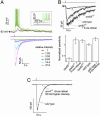Intrinsically photosensitive retinal ganglion cells detect light with a vitamin A-based photopigment, melanopsin
- PMID: 16014418
- PMCID: PMC1177370
- DOI: 10.1073/pnas.0501866102
Intrinsically photosensitive retinal ganglion cells detect light with a vitamin A-based photopigment, melanopsin
Abstract
In mammals, intrinsically photosensitive retinal ganglion cells (ipRGCs) mediate non-image-forming visual functions such as pupillary light reflex (PLR) and circadian photoentrainment. This photosensitivity requires melanopsin, an invertebrate opsin-like protein expressed by the ipRGCs. The precise role of melanopsin remains uncertain. One suggestion has been that melanopsin may be a photoisomerase, serving to regenerate an unidentified pigment in ipRGCs. This possibility was echoed by a recent report that melanopsin is expressed also in the mouse retinal pigment epithelium (RPE), a key center for regeneration of rod and cone pigments. To address this question, we studied mice lacking RPE65, a protein essential for the regeneration of rod and cone pigments. Rpe65-/- ipRGCs were approximately 20- to 40-fold less photosensitive than normal at both single-cell and behavioral (PLR) levels but were rescued by exogenous 9-cis-retinal (an 11-cis-retinal analog), indicating the requirement of a vitamin A-based chromophore for ipRGC photosensitivity. In contrast, 9-cis-retinal was unable to restore intrinsic photosensitivity to melanopsin-ablated ipRGCs, arguing against melanopsin functioning merely in photopigment regeneration. Interestingly, exogenous all-trans-retinal was also able to rescue the low sensitivity of rpe65-/- ipRGCs, suggesting that melanopsin could be a bistable pigment. Finally, we detected no melanopsin in the RPE and no changes in rod and cone sensitivities due to melanopsin ablation. Together, these results strongly suggest that melanopsin is the photopigment in the ipRGCs.
Figures






References
-
- Berson, D. M., Dunn, F. A. & Takao, M. (2002) Science 295, 1070-1073. - PubMed
-
- Lucas, R. J., Hattar, S., Takao, M., Berson, D. M., Foster, R. G. & Yau, K. W. (2003) Science 299, 245-247. - PubMed
-
- Ruby, N. F., Brennan, T. J., Xie, X., Cao, V., Franken, P., Heller, H. C. & O'Hara, B. F. (2002) Science 298, 2211-2213. - PubMed
Publication types
MeSH terms
Substances
Grants and funding
LinkOut - more resources
Full Text Sources
Other Literature Sources
Molecular Biology Databases

